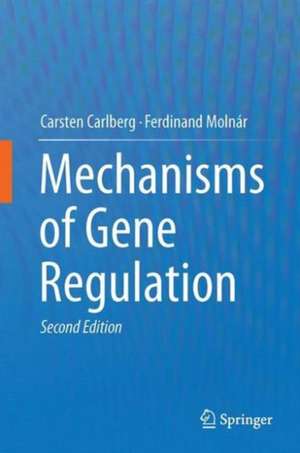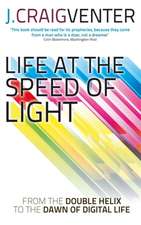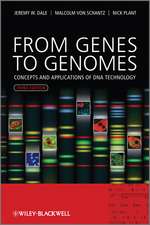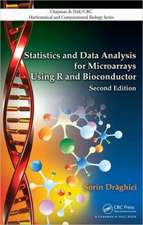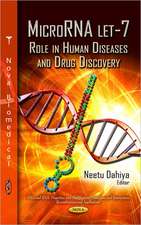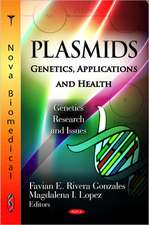Mechanisms of Gene Regulation
Autor Carsten Carlberg, Ferdinand Molnáren Limba Engleză Hardback – 16 iun 2016
A complete understanding of transcription factors and the processes that alter their activity is a major goal of modern life science research. The availability of the whole human genome sequence (and that of other eukaryotic genomes) and the consequent development of next-generation sequencing technologies have significantly changed nearly all areas of the biological sciences. For example, the genome-wide location of histone modifications and transcription factor binding sites, such as provided by the ENCODE consortium, has greatly improved our understanding of gene regulation. Therefore, the focus of this book is the description of the post-genome understanding of gene regulation.
The purpose of this book is to provide, in a condensed form, an overview on the present understanding of the mechanisms of gene regulation. The authors are not aiming to compete with comprehensive treatises, but rather focus on the essentials. Therefore, the authors have favored a high figure-to-text ratio following the rule stating that “a picture tells more than thousand words”.
The content of the book is based on the lecture course, which is given by Prof. Carlberg since 2001 at the University of Eastern Finland in Kuopio. The book is subdivided into 4 sections and 13 chapters. Following the Introduction there are three sections, which take a view on gene regulation from the perspective of transcription factors, chromatin and non-coding RNA, respectively. Besides its value as a textbook, Mechanisms of Gene Regulation will be a useful reference for individuals working in biomedical laboratories.
| Toate formatele și edițiile | Preț | Express |
|---|---|---|
| Paperback (2) | 442.00 lei 38-44 zile | |
| SPRINGER NETHERLANDS – 7 iun 2018 | 442.00 lei 38-44 zile | |
| Springer International Publishing – 30 oct 2020 | 498.61 lei 38-44 zile | |
| Hardback (1) | 704.36 lei 3-5 săpt. | |
| SPRINGER NETHERLANDS – 16 iun 2016 | 704.36 lei 3-5 săpt. |
Preț: 704.36 lei
Preț vechi: 828.66 lei
-15% Nou
Puncte Express: 1057
Preț estimativ în valută:
134.78€ • 141.10$ • 111.52£
134.78€ • 141.10$ • 111.52£
Carte disponibilă
Livrare economică 15-29 martie
Preluare comenzi: 021 569.72.76
Specificații
ISBN-13: 9789401777407
ISBN-10: 9401777403
Pagini: 192
Ilustrații: XVI, 211 p. 82 illus. in color.
Dimensiuni: 155 x 235 x 18 mm
Greutate: 0.63 kg
Ediția:2nd ed. 2016
Editura: SPRINGER NETHERLANDS
Colecția Springer
Locul publicării:Dordrecht, Netherlands
ISBN-10: 9401777403
Pagini: 192
Ilustrații: XVI, 211 p. 82 illus. in color.
Dimensiuni: 155 x 235 x 18 mm
Greutate: 0.63 kg
Ediția:2nd ed. 2016
Editura: SPRINGER NETHERLANDS
Colecția Springer
Locul publicării:Dordrecht, Netherlands
Cuprins
Overview: What is gene expression?.- The impact of chromatin.- The basal transcriptional machinery.- Transcription factors.- Linking signal transduction and gene regulation.- Switching genes on and off at the example of nuclear receptors.- Mapping the genome.- Chromatin modifiers.- Genomic imprinting.- The epigenome.- Chromatin remodeling.- Chromatin architecture.- Regulatory RNA.
Notă biografică
Prof. Carsten Carlberg: Professor for biochemistry at the School of Medicine, Institute of Biomedicine at the University of Eastern Finland. The main research interests of Prof. Carlberg are (epi)genomics of nuclear receptors and their ligands with special focus on vitamin D. So far he published more than 190 papers (H-index 50). Since 2003 he is lecturing yearly the course "Nutrigenomics", which is the basis of this textbook. Together with Dr. Molnár he also published the Springer textbook "Mechanisms of gene regulation".
Dr. Ferdinand Molnár: Senior researcher at the School of Pharmacy, Institute of Biopharmacy, University of Eastern Finland. The main research interests of Dr. Molnár are the molecular structure of nuclear receptor proteins and their natural and synthetic ligands, on which he published more than 20 papers (H-index 14). Together with Prof. Carlberg he published the Springer textbook "Mechanisms of gene regulation".
Dr. Ferdinand Molnár: Senior researcher at the School of Pharmacy, Institute of Biopharmacy, University of Eastern Finland. The main research interests of Dr. Molnár are the molecular structure of nuclear receptor proteins and their natural and synthetic ligands, on which he published more than 20 papers (H-index 14). Together with Prof. Carlberg he published the Springer textbook "Mechanisms of gene regulation".
Textul de pe ultima copertă
This textbook aims to describe the fascinating area of eukaryotic gene regulation for graduate students in all areas of the biomedical sciences. Gene expression is essential in shaping the various phenotypes of cells and tissues and as such, regulation of gene expression is a fundamental aspect of nearly all processes in physiology, both in healthy and in diseased states. This pivotal role for the regulation of gene expression makes this textbook essential reading for students of all the biomedical sciences, in order to be better prepared for their specialized disciplines.
A complete understanding of transcription factors and the processes that alter their activity is a major goal of modern life science research. The availability of the whole human genome sequence (and that of other eukaryotic genomes) and the consequent development of next-generation sequencing technologies have significantly changed nearly all areas of the biological sciences. For example, the genome-wide location of histone modifications and transcription factor binding sites, such as provided by the ENCODE consortium, has greatly improved our understanding of gene regulation. Therefore, the focus of this book is the description of the post-genome understanding of gene regulation. The purpose of this book is to provide, in a condensed form, an overview on the present understanding of the mechanisms of gene regulation. The authors are not aiming to compete with comprehensive treatises, but rather focus on the essentials. Therefore, the authors have favored a high figure-to-text ratio following the rule stating that “a picture tells more than thousand words”.
The content of the book is based on the lecture course, which is given by Prof. Carlberg since 2001 at the University of Eastern Finland in Kuopio. The book is subdivided into 4 sections and 13 chapters. Following the Introduction there are three sections, which take a view on gene regulation from the perspective oftranscription factors, chromatin and non-coding RNA, respectively. Besides its value as a textbook, Mechanisms of Gene Regulation will be a useful reference for individuals working in biomedical laboratories.
A complete understanding of transcription factors and the processes that alter their activity is a major goal of modern life science research. The availability of the whole human genome sequence (and that of other eukaryotic genomes) and the consequent development of next-generation sequencing technologies have significantly changed nearly all areas of the biological sciences. For example, the genome-wide location of histone modifications and transcription factor binding sites, such as provided by the ENCODE consortium, has greatly improved our understanding of gene regulation. Therefore, the focus of this book is the description of the post-genome understanding of gene regulation. The purpose of this book is to provide, in a condensed form, an overview on the present understanding of the mechanisms of gene regulation. The authors are not aiming to compete with comprehensive treatises, but rather focus on the essentials. Therefore, the authors have favored a high figure-to-text ratio following the rule stating that “a picture tells more than thousand words”.
The content of the book is based on the lecture course, which is given by Prof. Carlberg since 2001 at the University of Eastern Finland in Kuopio. The book is subdivided into 4 sections and 13 chapters. Following the Introduction there are three sections, which take a view on gene regulation from the perspective oftranscription factors, chromatin and non-coding RNA, respectively. Besides its value as a textbook, Mechanisms of Gene Regulation will be a useful reference for individuals working in biomedical laboratories.
Caracteristici
Set up as a figure-driven textbook, which means ratio of text to figures is low Written expertly on a modern field of general interest, based on 15 years of experience on teaching the course for which the textbook is designed Shows figures that are based on real protein structures
